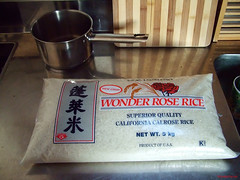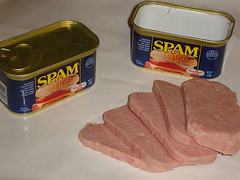You may wonder why I post articles regarding preparing for the worst or preparing for an emergency. Our economy is not going to hold up for very long. More and more people are becoming self-sufficient for a reason. Owning a garden in some states is ILLEGAL! Not having electricity in the home that you own is becoming ILLEGAL. This is all REAL whether you want to face the truth or not. Being prepared does not mean you're a fanatic, it means you are taking care of your family if you need to stay in your home for three or four days or a month due to rioting or due to flooding and you can't get to a store. These are real situations. Watch the news for a week. You'll see what I mean...
There is always something new to consider or a new and different way to present the same old information in a more useful manner. With that in mind, today I would like to share a method for getting started with your food storage program in an easy, step by step, and cost effective manner. The amounts may seem in excess, but take baby steps.
To be truthful, my initial goal with this article was to respond to readers who were just getting started and wanted a shopping list of things to buy for their food storage pantry. I also wanted to compile a checklist that more experienced preppers could use to compare what they had to what they needed. (*Note-A Prepper is a person prepared for an emergency...ANY emergency.) My goal can pretty much be summed up by saying that I wanted to write about getting started with food storage the easy way. No frills, no fluff – just a common sense list of food items to get you started.
With that goal in mind, let me say this: this is not a list of items intended for deep storage. Nor is it a list of items packaged so that they have a 25 year shelf life. (And in reality, do you really need your stored food to last that long?) I am also not going to list items that might be foreign to your palate, difficult to find, or too costly to absorb into your weekly shopping budget.
What you are going to get is a list of 20 items that can easily be purchased at your local grocery store, warehouse club and surprisingly, even online at Amazon. They can be purchased in one shot, all at once, or you can pick up one item from the list each week over a period of twenty weeks. The choice is yours. All I ask is that you consider getting each of the items on the list and that you also consider getting started sooner rather than later. I promise you that this will be easy.
I am going to include quantities that require no extra thought, no calculator and no formula for determining servings or overall quantities. Like I said. This is going to be EASY!
20 ITEMS TO KICK START YOUR FOOD STORAGE PLAN
1. 20 pounds of Rice. As boring as it may sound, rice is one of the backbones of every food storage plan. It is filling, nutritious and with the use of varied seasonings and condiments, highly adaptable in a variety of tasty meals. The choice of white, brown or a combination of the two is up to you. White rice has a longer shelf life but brown rice has more nutritional benefits. In my own household, I like to combine the two along with some Jasmine, Basmati and Calrose sticky rice.
2. 20 pounds of Pinto Beans. Like rice, beans are the backbone to every food storage plan. You may substitute white, kidney or other types of dried beans but honestly, pintos are one of the least expensive dried beans and in my opinion, one of the tastiest. Need help cooking beans? when you are done here be sure to read Survival Woman Learns to Cook Dried Beans and you should too and Respect for the Lowly Pinto Bean.
3. 20 cans of Vegetables. Green beans, peas, corn and canned tomatoes are good choices. Let your taste and budget guide you. Buy what you currently eat and enjoy.
4. 20 cans of Fruit. Peaches, pears, pineapple, fruit cocktail – again, this is your choice. Fruits add a nice sweetness to life and these days we all could use more of that.
5. 20 cans of Meat. Chicken, tuna, shrimp, salmon, Vienna sausages, beef stew and yes, even the ubiquitous Spam will satisfy this requirement. Did you know that you can even purchase canned roast beef? Again, let your taste and budget guide you – there is lots to choose from.
6. 4 pounds Oats. Remember when you were little and Mom warmed your tummy with a nice comforting bowl of oatmeal? That is what we are talking about here. A bowl of oatmeal topped with canned fruit can be enjoyed for breakfast, lunch or dinner.
7. 2 large jars of Peanut Butter. Peanut butter is an excellent source of protein, with plenty of calories for energy and sustenance. Besides, who can resist the taste of a gooey spoonful of luscious peanut butter?
8. 2 large jars of Tang or other powdered drink mix. The only requirement here is get something you like and something fortified with Vitamin C. I am not going to preach and tell you to avoid artificial sweeteners. If Crystal Lite works for you in normal times, go for it.
9. 5 pounds of Powdered Milk. Milk is a great source of protein and other nutrients. In addition it is filling and can be used to top your oatmeal cereal or stirred into your coffee as a flavor enhancer.
10. 5 pounds of Salt. It goes without saying that salt is an essential for survival plus it has a lot of uses other than as an enhancement for food. That said, our bodies need salt to survive. Read more about salt in the article Reasons You Need Salt in the Prepper Pantry.
11. 10 pounds of Pancake Mix. An all in one pancake mix (such as Krusteaz) only requires the addition of water to make up a batch of batter. As with oatmeal, a big plate of pancakes, perhaps with some honey or jam, will make a satisfying meal that can be eaten for breakfast, lunch or dinner.
12. 2 pounds of Honey and 2 large jars of Jam. We all need some sweetness in our life, even with Mother Nature or life deals us a blow. I choose honey and jam over sugar but at the end of the day, you can make a substitution or simply mix and match.
13. 10 pounds of Pasta. Pasta is familiar and easy to fix. Pasta is a dense form of wheat but so much easier to deal with when you are first starting out. Besides, it is a fabulous comfort food.
14. 10 cans or jars of Spaghetti Sauce. Cheap yet satisfying, canned pasta sauce on a bed of pasta creates a satisfying meal that can be put together in minutes.
15. 20 cans of Soup or Broth. The beauty of canned soups and canned broth is that they are a budget friendly. Soups are an all-in-one meal solution. All you need is a can opener and a spoon and you have a meal ready to go. For an extra satisfying meal, try using a can of soup as part of the cooking water for your rice. Yummy!
16. One large jug of Oil. Choose olive oil, coconut oil or some other cooking oil, but definitely get some. Oil is essential for good health, fueling our energy stores and providing support for fat-soluble vitamins and nutrients as they work their way through our system. Not only that, but a bit of fat in your diet adds flavor and makes you feel satisfied when you are done eating.
17. Spices and Condiments. Adding some spices and condiments to your food storage pantry will allow you to vary the taste of your storage foods, thus mitigating some of the boredom that is likely to occur over time. The exact mix of spices and condiments is up to you but some suggestions include garlic, chili, Tabasco (hot sauce), salsa, oregano, thyme and black pepper.
18. 5 pounds of Coffee or 100 Tea Bags. There are those that will say that life without coffee is not life at all. Whole bean (assuming you have a hand grinder), ground or instant – take your choice. Or substitute tea. Green tea and many herbal teas are quite therapeutic so if you like tea, this may be a good way to go.
19. 2 large bags of Hard Candies. Hard candy can go a long way toward making an unpleasant situation bearable. Butterscotch drops, peppermints and even lemon drops are good. Have fun with this and pick up a couple of bags of your favorites!
20. Mini LED Flashlight and Extra Batteries. Okay, this is a cheater item. It is not food but it is all important and so it will not hurt to stash a miniature flashlight or two along with the edibles in your food storage pantry. My top pick of the moment in the Blocklite. This thing just goes and goes and goes plus, it does not take up any storage space.
BUT THERE IS NO WHEAT AND NO FLOUR ON THIS LIST!
So you noticed!
There are no wheat berries or other whole grains (other than oats/oatmeal) on this list and there is also no flour. While there is a place for these items in a long term storage plan, I consider them part of the second phase of food storage.
The truth is that many preppers would not have a clue as to what to do with wheat, so why push the envelope?
The same goes with flour. To make flour usable, you also need yeast and baking powder plus the skill and know-how to bake. Not only that, you most likely will need an outdoor oven of sorts – especially if the grid is down post disaster. That, and more, will come later, but for now, while covering the basics, it is much simpler and far more practical to stick with easy to cook foods that can be combined into interesting meals without the need for much experience other than opening a can or a package.
~~~~~~~~~~~~~~~~~~~~
THE FINAL WORD
As you read though this list, I hope you can visualize the number and variety of meals that can be made by mixing and matching the items listed in the kick-start plan. How about some rice, salsa and canned chicken cooked into a casserole in your cast iron skillet? Or pancakes topped with canned peaches and honey? Then there are pinto beans, combined with rice and corn and topped with a bit of Tabasco for a fiesta-style meal.
Well okay, perhaps these are not gourmet delights but with the added condiments, they will taste good and be as healthy as you can expect food to be when fresh meats and produce or unavailable.
Is this a complete list of everything you will need to be fully prepared food-wise? Heck no. Are the quantities adequate to feed a family for a month, three months or longer? Perhaps a month but not much longer. Truthfully, for long term storage you need more food and more variety as well as some packaging methods (Mylar bags or buckets plus oxygen absorbers) to insure that your will food stay viable and pest free for years to come.
But for now we are more focused on either getting started our rounding out our basic survival pantry. And for that, these 20 items will do just fine.



Comments
Post a Comment